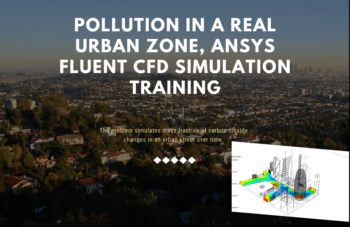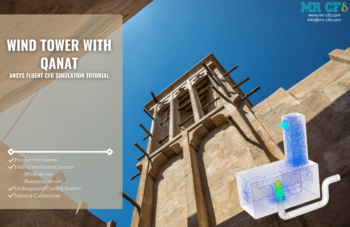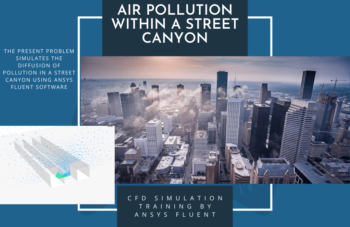Corona Virus Patient Steady Breathing in Clean Room
$160.00 Student Discount
- The problem numerically simulates the Corona Virus Patient’s Breathing in Clean Room using ANSYS Fluent software.
- We design the 3-D model by the Design Modeler software.
- We mesh the model with ANSYS Meshing software, and the element number equals 5666870.
- We use the Discrete Phase Model (DPM) to define the release of coronavirus particles.
- We investigate two factors to evaluate Thermal Comfort: PMV (predicted mean vote) and PPD (predicted percentage of dissatisfaction).
To Order Your Project or benefit from a CFD consultation, contact our experts via email ([email protected]), online support tab, or WhatsApp at +44 7443 197273.
There are some Free Products to check our service quality.
If you want the training video in another language instead of English, ask it via [email protected] after you buy the product.
Description
Corona Virus Patient Steady Breathing in Clean Room, ANSYS Fluent CFD Simulation Training
This project simulates the Corona Virus Patient STEADY Breathing in Clean Room using ANSYS Fluent software.
Hospital rooms need air conditioning. These air conditioners can continuously transfer the flow of fresh air into the interior of the room to clean the polluted air around the patient. These air conditioners are also used to provide proper cooling and heating.
In this simulation, a room with a bedridden patient is examined. The patient has corona and spreads the coronavirus particles to the environment. The patient’s mouth is distinctly defined as the source of respiratory coronavirus transmission.
Also, the patient’s body surface has a temperature of 308 K, which is one of the symptoms of his disease. The fresh air from air purification systems causes the polluted air and virus particles to be removed from the room’s interior. Secondly, it helps to cool the patient’s body surface and create thermal comfort for the patient.
Therefore, several panels are defined on the room’s ceiling for the entry of fresh air with a temperature of 294 K, and the air outlet is also from the panels of the lower part of the side walls.
The 3D geometry is drawn by Design Modeler software. The model is then meshed by ANSYS Meshing software. The model mesh is unstructured, and 5666870 cells have been created.
Corona Virus Methodology
In this modeling, the Discrete Phase Model (DPM) is used to define patient respiration and the release of coronavirus particles. If it is necessary to study the behavior of several discrete particles in a continuous medium, the solution approach must be changed from Eulerian to Lagrangian.
In this approach, their behavior is investigated by tracking discrete particles in a continuous fluid. When a corona patient breathes, the coronavirus spreads as discrete particles from the patient’s mouth to the surrounding air as a continuous environment.
So there is a need to use the Lagrangian perspective. Therefore, DPM must be used to modulate fluid behavior and define an injection for virus particles injected from the patient’s mouth. The virus particle type is inert, and the injection type is surface.
If the particles cross the boundary, the escape is used. If particles hit the wall boundary, the trap or reflect is used.
Corona Virus Conclusion
After simulation, contours of velocity, temperature, and pressure are obtained. Air conditioning pathlines are also provided. These results show that fresh airflow from the ceiling panels enters the room’s interior and is directed to the outlet panels after complete circulation inside the room.
Since DPM is used, particles of the virus released from the patient’s mouth are shown. The figures show that these virus particles are affected by the airflow of the air conditioning system. It means that they are directed by the fresh airflow to the outlet panels to be cleaned inside the room.
The concept of thermal comfort becomes important when modeling air conditioning systems. In this simulation, two parameters, PMV (predicted mean vote) and PPD (predicted percentage of dissatisfied), are used as factors to evaluate the degree of thermal comfort.
PMV value was obtained according to people’s votes in the different experimental thermal conditions. This parameter depends on various variables, including air temperature, humidity, airspeed, people’s physical activity, etc.
This parameter varies between -3 to +3. PPD value is then defined as an exponential function of PMV. This parameter indicates people’s degree of satisfaction or dissatisfaction with the thermal conditions of the environment. The results show that the values of PMV and PPD are suitable in terms of thermal comfort.



















Benjamin Beahan –
How does this simulation model the spread of the coronavirus in a patient’s room?
MR CFD Support –
This simulation uses advanced CFD techniques to model the spread of the coronavirus in a patient’s room. It takes into account factors such as air flow, temperature, and humidity, which can all affect virus transmission.
Kirsten Hagenes –
What’s the particle type in injection?
MR CFD Support –
We use the surface injection type to simulate this project.
Thelma Rippin –
This site always provides the latest content to the scientific community.
Elissa Morissette IV –
How does this simulation take into account the impact of airflow on virus spread?
MR CFD Support –
The simulation uses advanced fluid dynamics models to simulate air flow in the patient’s room. It considers factors such as air velocity and turbulence, which can affect virus transmission.
Prof. Addie Senger I –
How does this simulation model the impact of temperature and humidity on virus spread?
MR CFD Support –
The simulation includes advanced heat and mass transfer models to simulate the impact of temperature and humidity on virus spread. These factors can affect the survival and transmission of the virus in the air.
Brant Brekke III –
How does this simulation model the impact of room occupants on virus spread?
MR CFD Support –
The simulation includes models for room occupants, who can emit virus particles into the air. It can simulate the impact of factors such as breathing rate, coughing, and sneezing on virus spread.
Dr. Marilie Heller –
The training for the Corona Virus Patient Steady Breathing in Clean Room CFD Simulation was incredibly insightful. The methodology detailed in virus particle simulation and airflow analysis using DPM in ANSYS Fluent was quite in-depth. It played a key role in understanding the dynamics within a clean room environment and the effect of air conditioning on airborne pathogens. Brilliant work!
MR CFD Support –
We greatly appreciate your positive feedback on our CFD simulation training. It’s gratifying to know that the content was helpful and provided deep insights into clean room dynamics and pathogen dispersion. Thank you for recognizing our efforts to deliver comprehensive learning materials. If you have any further questions or require additional training on related topics, feel free to reach out to us!
Lily Ortiz –
Fantastic resource for understanding the application of CFD in healthcare settings! It is clearly explained how air purifying systems work to remove virus particles using the DPM. Has MR CFD published any video tutorials to further explain the practices necessary for simulating these kinds of clean rooms efficiently?
MR CFD Support –
We’re thrilled you found the training on Corona Virus Patient Steady Breathing in Clean Room helpful! While we do have a variety of tutorials and written resources, we continually work on providing more comprehensive guides, including video tutorials. If you stay connected with us, you’ll be the first to know once new materials are released. Remember to check our website and subscribe to our newsletter for the latest updates in CFD learning materials. Thank you for your positive feedback!
Mr. Keshaun Hagenes V –
Hello, we need this type of CFD analysis. Can you do it?
MR CFD Support –
Hi, You can send your project to the following addresses:
+90 (535) 951 97 42
[email protected]
Rosetta Schinner V –
The CFD simulation really highlighted the importance of efficient air circulation in controlling virus spread. Nice job demonstrating how adjustments in AC systems can impact safety and comfort in hospital settings. Wondering, were any specific factors aside from temperature considered for determining the PMV and PPD, like clothing insulation?
MR CFD Support –
Thank you for your positive feedback! In this simulation, PMV and PPD were primarily assessed based on temperature, air velocity, and humidity conditions. However, other factors like human metabolism and clothing insulation were not directly considered but have an overlooked contribution encoded in boundary conditions and assumptions in line with typical healthcare settings.
Dr. Devante Nienow MD –
Can this simulation be used to evaluate the effectiveness of different air conditioning systems in preventing virus spread?
MR CFD Support –
Yes, the simulation can be adjusted to evaluate the effectiveness of various air conditioning systems. By accurately simulating virus spread, it can help identify the most effective air conditioning designs for preventing virus transmission.
George Bashirian –
The training was incredibly detailed and instructive, providing a clear understanding of how to simulate steady breathing in a clean room and assess air quality and thermal comfort. The application of DPM for virus particles spread visualization is particularly insightful. Great job incorporating PMV and PPD assessments for thermal comfort too!
MR CFD Support –
Thank you for your positive feedback! We’re delighted to hear that you found the simulation training on Corona Virus Patient Steady Breathing in a Clean Room to be detailed and helpful. It’s great to know our efforts to explain the Discrete Phase Model and the inclusion of thermal comfort assessments are appreciated. If there’s anything else we can assist with or any further topics you’re interested in, let us know!
Prof. Dewayne Stark V –
The results you’ve obtained for PMV and PPD indicate good thermal comfort, but I’m curious about how these indicators are displayed as contours. Can you explain a little more about their visualization in the simulation results?
MR CFD Support –
In ANSYS Fluent, the PMV and PPD values can be visualized as contour plots following the simulation. A specific function is included for calculating these values based on inputs like temperature, humidity, and airflow, all of which are part of the comfort parameters. Once calculated, they can be selected like any other scalar quantity, and their spatial distribution within the room can be shown as contour plots on various surfaces or planes in the computational domain. These contours essentially allow the visualization of thermal comfort levels in different parts of the room.
Tevin Huel –
The CFD tutorial on CoronaVirus Patient Steady Breathing in a Clean Room was excellently structured. Following the well-detailed methodology, I could understand the significance of using DPM for virus particle simulation. The defined virus particle release from the patient’s mouth and how the air conditioning affects these particles was eye-opening. These insights are pivotal for designing efficient hospital HVAC systems amid pandemics.
MR CFD Support –
Thank you for your kind words! We’re glad to hear that our ANSYS Fluent CFD Simulation training session on steady breathing of a coronavirus patient in a clean room was insightful and helpful to you. Understanding virus particle dynamics within a controlled environment is indeed crucial for healthcare facility management, especially during these trying times. We appreciate your positive feedback and we’re pleased to know that you found the methodology detailed and instructional. If you need further assistance or have more interest in our simulations, you’re always welcome to reach out!
Kellen Flatley –
I’m very impressed with the detailed explanation of how airflow and aerosol particle movements were simulated in the clean room and the way thermal comfort is assessed using PMV and PPD. It’s great seeing such sophisticated modeling being used for safety and comfort in healthcare settings, especially during a pandemic.
MR CFD Support –
Thank you for recognizing the detailed work in the simulation! We are pleased to hear that the explanation of the airflow, aerosol particle behavior, and thermal comfort evaluation using PMV and PPD parameters have met your expectations and helped provide valuable insights. Your feedback is crucial for us in improving and validating our efforts in healthcare safety and pandemic research using CFD simulations.
Dortha Leannon –
I am thoroughly satisfied with the simulation’s detailed representation of the clean room’s airflow and virus particle spread. The use of PMV and PPD to assess thermal comfort in this context adds great value to the analysis.
MR CFD Support –
We are delighted to know that the inclusion of PMV and PPD assessments met your expectations and added substantial value to your understanding of the thermal comfort within the clean room simulation. Thank you for your positive feedback, and we appreciate your recognition of the simulation’s intricate details.
Verna Lehner –
The simulation seems incredibly detailed. Is there any visualization of particle movement and how exactly is this informing the virus spread mitigation strategies?
MR CFD Support –
Yes, the simulation provides detailed visualization of particle movement using the Discrete Phase Model (DPM). These visualizations show the path of virus particles through the air as affected by the ventilation system. By analyzing these visualizations, one can determine the effectiveness of air flow patterns and positions of the air outlets in removing virus particles from the room, thus aiding in the development of improved virus spread mitigation strategies in healthcare settings.
Anthony McCullough –
The simulated thermal comfort levels seem essential, but how is the PMV actually calculated within ANSYS Fluent during the simulation of steady breathing in a clean room?
MR CFD Support –
In ANSYS Fluent, the PMV is calculated based on a comfort model whose parameters are user-defined inputs accounting for air temperature, radiant temperature, air speed, humidity, clothing insulation, and metabolic rate. To calculate PMV, Fluent employs the comfort parameters along with empirical correlation equations derived from ASHRAE Standard 55 or ISO 7730, which in turn relate the environmental conditions to thermal satisfaction levels experienced by group of people.
Lazaro Terry –
This CFD simulation training was fantastic! Not only did it help me better understand airflow dynamics in a healthcare setting, but it was also crucial in appreciating how particle tracking works within ANSYS Fluent. The visual representations of virus particle dissemination and the airflow management were top-notch and made the concepts much clearer.
MR CFD Support –
Thank you for your kind words! We’re delighted to hear that our Corona Virus Patient Steady Breathing in Clean Room simulation training provided you with a clear and comprehensive understanding. We put a lot of effort into making sure our visual aids enhance the learning experience. It’s great to know they helped you grasp the complex airflow and particle tracking concepts. If you have any further questions or need more depth on any topic, feel free to reach out. Otherwise, we wish you the best in your continued learning and application of ANSYS Fluent!
Haylie Krajcik –
Can this simulation be used to evaluate the impact of different ventilation strategies on virus spread?
MR CFD Support –
Yes, the simulation can be adjusted to evaluate the impact of various ventilation strategies on virus spread. This includes different ventilation rates, air distribution methods, and filtration systems.
Dr. Jess Lowe DVM –
The attention to detail in the simulation of a patient’s steady breathing in a clean room recreating the spread of coronavirus particles is impressive. It’s fascinating how advanced CFD simulations can help ensure a safe environment in healthcare settings.
MR CFD Support –
We greatly appreciate your feedback on our Corona Virus Patient Steady Breathing in Clean Room CFD Simulation Training using ANSYS Fluent software. It’s truly rewarding to hear that our careful consideration of details helps demonstrate the effectiveness of air purification systems in maintaining a safe and comfortable environment for patients. Thank you for recognizing the effort and for your positive review of our product.